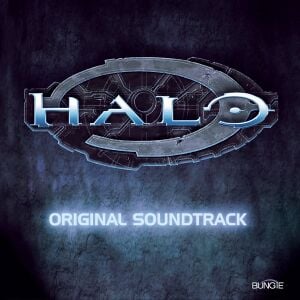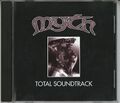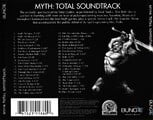Music of Halo: Combat Evolved
From Halopedia, the Halo wiki
The music of Halo: Combat Evolved is the musical score to Halo: Combat Evolved.
Development[edit]
Initial development[edit]
In July of 1999, Martin O'Donnell and Michael Salvatori began composition for the Halo Theme. At the time, O'Donnell and Salvatori were partners at the freelance production company TotalAudio, composing commercial jingles and music for earlier Bungie games, including Myth: The Fallen Lords, Myth II: Soulblighter, and Oni.[1][2]
Director of Cinematics Joseph Staten approached O'Donnell and Salvatori for a backing track to the Halo MacWorld demo, five days prior to the presentation. Staten wanted a composition that evoked the game's "ancient, epic and mysterious" atmosphere.[3] With that prompt, O'Donnell drew inspiration from his studies on Middle Ages music and incorporated phrases of Gregorian chant into the theme.[4][2] The theme was also influenced by the first verse of The Beatles' song "Yesterday", which inspired the same four-phrase structure of the Gregorian chant.[5][2] In the Remaking the Legend documentary, O'Donnell stated that he laid down the core melody of the theme during the half-hour drive to Salvatori's house, which doubled as their studio.[3] The actual audio was performed by an orchestra composed of six string instruments — four violins and two cellos — and recorded the day before the MacWorld presentation. The Halo Theme has since become an iconic motif, for the series as well as video game soundtracks as a genre.[4]
Later development[edit]
Microsoft acquired Bungie after the presentation at MacWorld, in May 2000, and the platform for Halo moved from the PC/Mac to the Xbox. Adapting to the music implementation system specific to the audio specifications on the Xbox presented significant obstacles to O'Donnell and Salvatori.[2] The rest of the soundtrack took shape over the course of 2001, with O'Donnell specifically citing the time between July and September as a "hellish blur".[6]
After Microsoft's acquisition of Bungie, O'Donnell moved to Seattle with the rest of Bungie, as he was under contract with Bungie for Oni and Halo, while Salvatori remained at Chicago to run TotalAudio.[4] The two sent their music to each other for feedback and suggestions. Different aspects of the Halo Theme, including the Gregorian chant and string melody, would appear in other tracks in the game.[2] O'Donnel described the style of the soundtrack as "a little Samuel Barber meets Giorgio Moroder".[6]
Since a fire had burnt down their studio in 1999, O'Donnell and Salvatori took the opportunity to upgrade to newer equipment, thus enabling the production of music in 5.1 Surround Sound, as well as digital, hard disk based recordings.[7] The soundtracks featured patches and samples from the Proteus 2000 and the Kurzweil K2500X synthesizers and more.[8]
The finalized tracks frequently employed MIDI recordings, featuring keyboards, synths, and samplers as well as digital recording equipment controlled by computers. Some tracks featured live instrumental performances alongside the MIDI recordings, while other tracks only featured the live performance adapted from the MIDI recordings. The music was then cut and edited into chunks, so that the audio engine could respond dynamically to the player's actions.[6] O'Donnell and Salvatori worked closely with the level designers in order to match the audio design to points of tension and release within each level. Level designers’ feedback took priority in changes made to the compositions.[6] O'Donnell also played the game during development and made changes based on his own observations, like inserting silence into moments with higher tension. He also developed musical loops to places where he anticipated players would spent extended time in certain gameplay sequence.[4]
While working with the level designer of Assault on the Control Room, O'Donnell included an Easter egg. A track from the Myth: The Fallen Lords would play if the player reached the top of the control room structure in the level. This track, titled Siege of Madrigal, was then featured in the official soundtrack as a bonus track following the Halo Theme. Since then, Siege of Madrigal became a recurring Easter egg in all of the Bungie Halo games.
At one point in development, Joseph Staten wanted to license and play "Paint it Black" by the Rolling Stones in the mid-level cinematic of 343 Guilty Spark, during the Pelican ride with Sergeant Avery Johnson and the Marines. Ultimately, Shreddin' was composed specifically for the cinematic and represented the in-universe flip music.[9][10]
Several tracks did not pass the sketch phase of composition, while alternate versions of released tracks were cut from the game. These tracks were later made available for download on Bungie.net:[11]
- Halo Love Theme Sketch: A variation of the Halo Theme, featuring a solo piano and an alternative ending.
- Rhythm Sketch Variant: A high strings variation of the heavy strings from the Halo Theme melody.
- String Sketch: A variation of the Halo Theme, featuring strings.
- Fast Sketch: A short sketch featuring the piano.
- Battle Sketch: An early version of Brothers In Arms featuring the piano.
- Club: A sketch that drew inspiration from the music of American rock band Devo, which used synthesizers.[12] The track was arranged into How to Get Ahead in War for Halo: Combat Evolved Anniversary.
- Seriously: A slow percussive beat joined by horns playing the bass melody of The Gun Pointed at the Head of the Universe.
- What?: The Halo Theme accompanied by slow beats.
- Tron: A sketch that was inspired by 1980s electronica.[13] The synth melody in the second half was repurposed for the second half of the "reveal theme" from Truth and Reconciliation Suite, while the track itself was arranged into Heretic Machine for Halo: Combat Evolved Anniversary.
Performer Credits[edit]
Musicians[edit]
|
Singers[edit]
|
Legacy[edit]
Martin O'Donnell and Michael Salvatori continued to reference the motifs from Halo Theme in other tracks in Halo: Combat Evolved and further compositions for the franchise. O'Donnell refers to this approach as creating "emotional equity", a sense of familiarity felt whenever themes are being repurposed, remixed, and reused throughout the series.[14] This tradition extended to future composers in the franchise; for example, the space theme from Opening Suite appears in Halo 2, Halo Legends, Halo: Reach, Halo 4, and Halo 5: Guardians, all of which featured the motif being used as a backing track for a scene set in outer space.
The iconic Halo Theme would appear in every piece of Halo media. While only a few tracks other than the Halo Theme were given new renditions in Halo 2, many more pieces from Halo: Combat Evolved reappeared in Halo 3. For the remastered release of Halo: Combat Evolved Anniversary, the original soundtrack was rearranged and reorchestrated in its entirety.
Official Soundtracks[edit]
Myth: Total Soundtrack[edit]
In 1999, the Myth: Total Soundtrack was released. Although the album was intended to be a compilation of the soundtracks of Myth: The Fallen Lords and Myth II: Soulblighter, the fortieth and final bonus track in the album was the Halo Theme from the E3 1999 trailer.
2002 Release[edit]
- Main article: Halo: Original Soundtrack
In an interview held after the release of the Halo E3 2000 trailer, Martin O'Donnell expressed interest in the soundtrack being sold.[15] After the game's release, O'Donnell was approached by Nile Rodgers who founded the recording label Sumthing Else Music Works for distributing video game soundtracks.[3] The official soundtrack featured all of the music from the game, except for the track that would be known as The Lost Song, which was later released on Bungie.net with music cut from the game.[11]
2003 Special Edition[edit]
After the Halo 2 E3 demo, a special edition of the soundtrack was released with bonus features on the Halo 2 demo, including previews of two Halo 2 soundtracks, The Last Spartan and Ghosts of Reach.
Halo Trilogy: The Complete Original Soundtracks[edit]
- Main article: Halo Trilogy: The Complete Original Soundtracks
In 2008, after the release of Halo 3, a box set was released, featuring the Halo: Original Soundtrack, the Halo 2: Original Soundtrack, Volume 2, and the Halo 3: Original Soundtrack.
Gallery[edit]
Sources[edit]
- ^ halo.bungie.org, Halo Music by TotalAudio (audio gurus) (Retrieved on Jun 23, 2021) [archive]
- ^ a b c d e YouTube - Martin O'Donnell, Composing Music for Halo, Destiny, and Golem (Retrieved on Jun 23, 2021) [archive]
- ^ a b c Remaking the Legend
- ^ a b c d YouTube - Academy of Interactive Arts & Science, Halo and Destiny Composer, Marty O'Donnell | The AIAS Game Maker's Notebook
- ^ IGN, How The Beatles Influenced the Halo Theme Song (Retrieved on Jun 1, 2020) [archive]
- ^ a b c d Xbox.com, Halo: Combat Evolved - Just the Right Sense of "Ancient" (Retrieved on Mar 1, 2007) [archive]
- ^ FragMusic.com, Crank It Up... Take Aim... Fire! (Retrieved on Apr 21, 2000) [archive]
- ^ Google Sheets, Mythic Restoration Project: Halo Patch List (Retrieved on Jun 21, 2021) [archive]
- ^ Halo 3 Legendary Edition, Halo: Combat Evolved developer commentary
- ^ Bungie.net, Halo Music Outtakes Part 1 (Retrieved on Oct 13, 2014) [archive]
- ^ a b Bungie.net, Media Player - Halo Music (Retrieved on Oct 25, 2020) [archive]
- ^ Bungie.net, Halo Music Outtakes Part 2: 6/26/2002 3:12 AM PDT (Retrieved on Feb 7, 2021) [archive]
- ^ Bungie.net, Halo (Xbox) Soundtrack and Music - audio_music.xml (Retrieved on Jan 26, 2021) [archive]
- ^ YouTube - The Act Man, A LEGENDARY Interview with Martin O'Donnell (Composer From Bungie, Halo, Destiny)
- ^ 3D Action Planet, Battleground: Halo (Retrieved on Jun 21, 2000) [archive]


